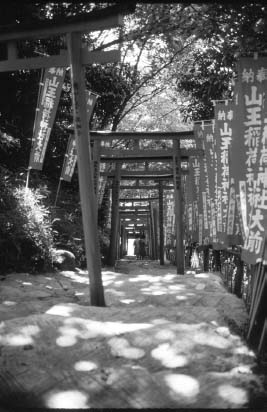ShintoSigns and Symbols |
Do Shinto practitioners mark sacred spaces with any distinctive signs and symbols? |
Easily the most important symbol of Shinto sacred spaces is the torii gate. Marking the entry and pathways to every shrine, torii typically consist of a pair of unadorned upright columns and a pair of crossbeams (or lintels) at the top. The upper crossbeam generally sits directly atop the column and protrudes on both sides, while the lower beam either ends at the columns or goes through and protrudes. Some torii have more elaborate uprights and crossbeams, depending on local and regional architectural styles. Devotees give torii as votive offerings to some shrines, lining pathways with hundreds of them inches apart, so that the entry to the shrine feels almost like a covered walkway. According to legend, the torii recalls the perch from which birds sang to entice the sun goddess from her cave.
Most Shinto shrines use the simplest and most natural materials available, imitating nature as much as possible. Natural wood grains and the lovely green forest patina that eventually accents thatch or wood-shingled roofs give them a rustic character and charm. Many shrine roofs still display remnants of primitive architectural elements as a reminder of antiquity. Although newer building methods no longer require them, many shrines retain a row of logs called katsuogi set along the ridge beam of the roof. Older structures needed the katsuogi to hold the thatch roof down. Another bit of architectural nostalgia are the vertical extensions of the eave beams above the roofline. As you view a shrine from either front or rear, you notice that the roofline forms an X. Horizontally trimmed upper ends of these beams, known as chigi, mark the shrines of female kami, and vertically trimmed ends those of male kami. Several rather mysterious symbols adorn holy places, whether or not the site has a structure on it. Thick straw ropes called shimenawa mark sacred places such as trees and rocks. Outer portals of shrines, whether actual buildings or miniature models used on home altars, also suspend shimenawa across their facades. Attached to the rope are pieces of white paper cut in zigzag fashion symbolizing offerings to the kami. The same bits of paper are attached to a ritual wand called the gohei. Legend has it that the rope originated as a way of restraining the sun goddess from escaping back into her cave.

A tunnel of torii gates, votive offerings of worshippers, lines the path up from street level to the hill on which the Hie Jinja shrine rises above the bustle of Tokyo’s Akasaka Mitsuke business district. The Hie Jinja is one of the shrines associated with a kami known as the Mountain King (Sanno).
